Monika Antal, Executive Manager
Recently, I ‘attended’ The graduate labour market post COVID-19: priorities for university careers services and the role of universities, employers and government in preparing students event, hosted by the Westminster Higher Education Forum. With the economic crisis presenting new challenges for many young people seeking employment, including graduates, here is what I found out: Charlie Ball from Prospects presented an insightful snapshot of the latest reading of the UK economy and the graduate labour market. In a nutshell, the economy is experiencing slow and stuttering improvement and we’re nowhere near back to where we were pre-pandemic. Even then, economic growth had been anaemic at a macro level since the Global Financial Crisis and Great Recession. PWC’s expectation is that the UK economy would recovery to pre-February 2020 levels by the end of 2021 at the earliest.
According to Charlie’s research, in mid-October 2020: 86% of businesses were trading, 9% of the staff were on partial or full furlough leave, 28% of the total workforce was working remotely: note that 74% of IT and 62% of professional services employees were working from home, 19% of businesses say that increased home working will become a permanent part of their business model. The level of vacancies was running at about 55-65% (depending on source) of normal rates, but it really varies by sector.
The graduate labour market has suffered serious damage, but many key graduate employment sectors, such as health, social care, IT, finance have been less affected than many other parts of the economy. Vacancies have held up reasonably well in the health sector, for example, which has the largest number of vacancies of all UK industries. There are positive signs of pick-up in accounting and finance, law, warehousing and logistics, engineering (particularly electrical and chemical), construction, and parts of manufacturing (distilling and automotive), informatics and medical technology.
Arts may be the worst-affected sector in the UK, but hospitality, retail, travel and accommodation have been hit very hard as well. And these tend be industries that provide many jobs for women in particular and for students who often seek temporary employment. They are also where many low paid jobs exist.
According to the British Chamber of Commerce economic analysis, recruitment and demand issues persist:
- In the years leading up to the pandemic around 3 in 4 businesses were struggling to fill job vacancies;
- Low levels of productivity, increased automation and an ageing workforce will continue to present significant challenges for business;
- The introduction of a new point-based immigration system from January 2021 will increase recruitment and employment costs for firms unable to fill job vacancies from the local labour market;
- Firms were investing less in training and development in 2018 than they were in 2014.
According to the Business Barometer published by the Open University: 56% of UK organisations continue to experience skills shortages as of Q3. Whilst the Chartered Institute of Personnel and Development (CIPD) found that 19% of employers have increased recruitment over the pandemic or are planning to recruit.
The Employer Skills Survey (ESS) from the Department for Education found that in 2019:
- Hard to fill (HTF) and skills shortage vacancies (SSVs) were ‘up’ on 2017;
- 24% of vacancies were in SSVs: particularly in construction and manufacturing;
- Employers had reduced training since 2017 – 60% of staff had received training in 2019;
- HTF were more prevalent for high skilled jobs;
- Vacancies that were particularly hard to fill included: professionals in IT, business services, education and public administration, associate professionals in financial services, public administration and carers;
- Main reasons for HTF at graduate level included: low number of applicants with required skills, not enough people interested in doing the job, just not enough applicants, for some associate professional roles, and lack of work experience.
What does the future hold?
- PWC expect demand for labour to fall by about 5% over the course of 2020, and GDP to fall about 10%;
- There will be significantly more remote working – CIPD expect the number of home workers to at least double and 65% of employers say remote working has had an impact and improved employee productivity;
- McKinsey modelling shows STEM as being the highest growth area of the European labour market up to 2030, even when taking automation into account;
- The British Chamber of Commerce warns that business training has fallen and there are still significant shortages and recruitment difficulties in many parts of the graduate economy (not only STEM);
- Job opportunities in health and social care will increase;
- Low carbon workforce is set to triple by 2030;
- Demand for digital skills and creativity, critical thinking, interpersonal communication skills and leadership skills will become even more important.
This brings me to two recommended readings: the first one, a scoping study that the Sustainability Exchange has been working on titled: Future Graduate Skills. This scoping study aims to bring further understanding to the area of changing graduate requirements, graduate skills gaps, and sustainability skills. The second, Jobs for a strong and sustainable recovery from Covid-19 by the Centre for Economic Performance (CEP) and the Grantham Research Institute on Climate Change and the Environment suggests that tens of thousands of jobs could be created by the move to a net-zero economy.
Check back here for part 2 of this blog to find out the ways in which YU members are engaging in the sustainability and green skills agenda, as part of post-COVID recovery and rebuilding work.












